In this article, we are going to take a look at one of the most important features of a guitar – pickups. Pickups affect your tone, your guitar volume, and ultimately factors in heavily to what your guitar will sound like coming out of the guitar amplifier.
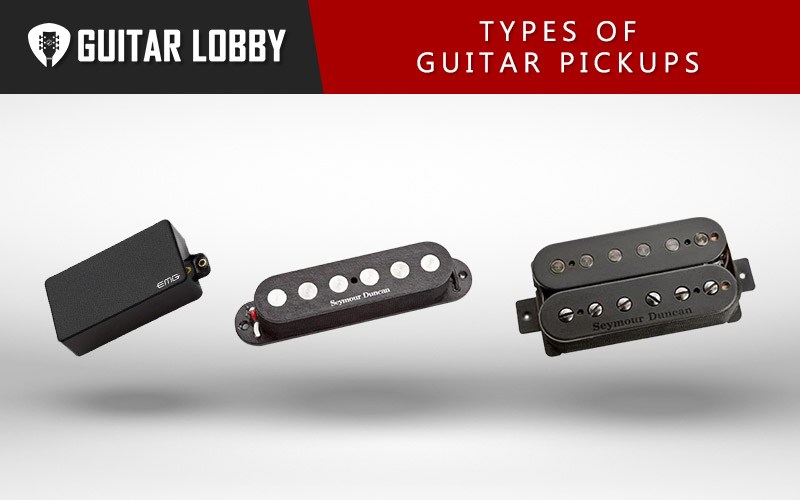
Various types of magnets, winding methods, and design characteristics can drastically change the tone of the guitar. Therefore, a critical step for guitarists to nail down the tone they are looking for is to have a good grasp of how pickups function and the design characteristics of a particular pickup. We are going to take a look at everything from single coil pickups, humbuckers, P90s, and even acoustic guitar as well as bass guitar pickups. Now let’s take an in-depth look at the types of guitar pickups and how to choose the right ones for you. For those of you who are beginner guitarists, I think you’ll find the video below useful as well.
Here Are the Different Types of Guitar Pickups
In this section, we’ll discuss the different types of electric guitar pickups, acoustic guitar pickups, and bass guitar pickups.
1. Single Coil Pickups (Electric Guitar)
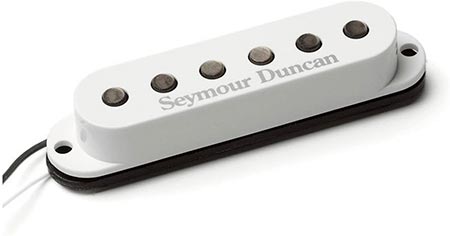
Single coil pickups are one of the most common types of pickups you can find, and it literally has single coil magnets on the pickup. Single coil pickups are also the first electric pickups to be invented, and it’s been loved and used by guitar players around the world since the 1930s. Single coil pickups are known for their sharp, biting tone that we heard on countless blues, RnB, and rock classics that we grew up with. Compared to P90s or humbuckers, single coil pickups are much clearer and more focused. Because of this, single coils are the most widely used for genres like funk, surf, soul, and country. And by combining it with a little bit of overdrive, it’s a great choice for genres like blues and rock.
One downside of single coil pickups might be that it has more feedback than humbucker pickups. Especially with some gain in your guitar tone, you’re bound to run into quite a bit of feedback with a single coil pickup. So that’s one of the reasons why single coil pickups aren’t usually the first pick when it comes to hardcore genres like metal or hard rock. Single coil pickups are also very affordable to buy, so it’s really easy to try out different models and brands. Now let’s look into the history of the single coil pickups.
2. Humbucker Pickups (Electric Guitar)
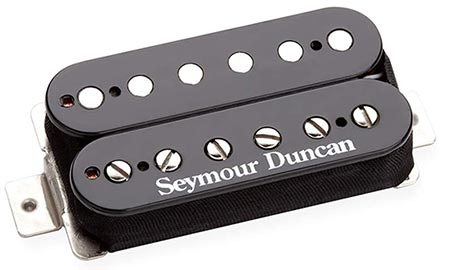
Humbuckers were revolutionary for pickups; they use two magnet coils wound in reverse to one another, which cancel out the hums and the noise resulting from pickup feedback signals. Humbuckers produce a thicker, warmer, and bigger output relative to single coil pickups. Because of the warmer tone, humbuckers are the staple pickup to jazz music and are also beloved by blues and rock guitarists.
3. Mini Humbuckers (Electric Guitar)
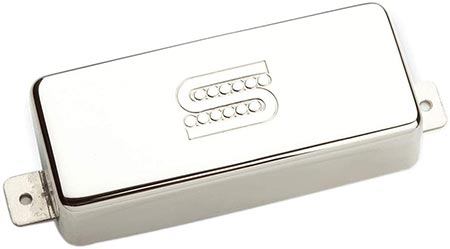
A mini humbucker is a type of humbucker that was created by Epiphone. It’s basically a Gibson PAF humbucker, but the size is noticeably narrower and therefore processes a smaller amount of signal compared to humbuckers. While the PAF humbuckers produce a thick, warm, and big sound, the tone from mini humbuckers can be described as a bright and clear tone. The size is somewhere between a single coil and a humbucker, and they are often used for jazz guitars. You can find these pickups on many Gibson and Epiphone guitars like Gibson Firebird guitars. Nowadays, you can find major pickup companies like EMG, Seymour Duncan, DiMarzio producing their own line of mini humbuckers.
Popular Related Article: 21 Of Our Favorite Humbucker Pickups
4. Active Pickups (Electric Guitar)
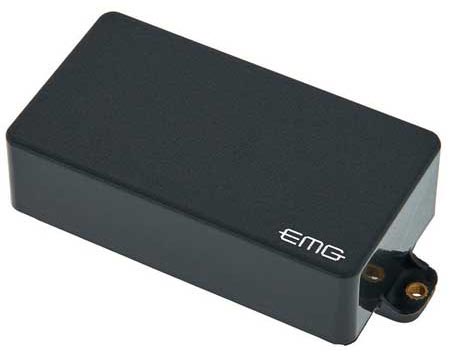
Active Pickups are types of pickup that will boost the signal of the guitar using an “active” preamp circuit, an active circuit meaning it needs an exterior power source. Typically a 9V battery will be used to power active pickups. By using batteries, the overall amount of output will also be increased and you can also boost the frequencies like treble, or bass as well. This is especially good for acoustic-electric guitars and performing with acoustic guitars on stage because then you can control the possible feedback and make all the adjustments that you need to make. With electric guitars, the boosted signal and the powerful output can also be super imperative when it comes to getting that hard rock or metal tone. This is why you will usually see active pickups on most of the rock, metal, and even blues guitars. Active pickups produced by companies like Seymour Duncan or EMG will pack so much more output and boost the signal by a lot more than your passive pickups.
5. P90 Pickups (Electric Guitar)
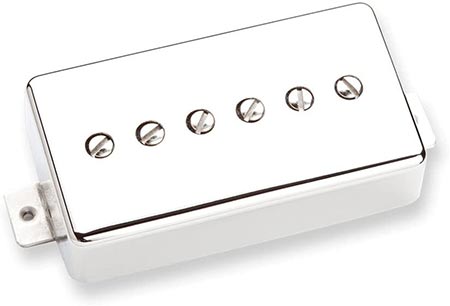
P90 pickups are essentially single coil pickups, but oftentimes they are described as pickups that are somewhere in between single coils and humbuckers. Engineering-wise, they are basically a type of single coil pickups because they also use single coil magnets. But due to things like wider bobbins and bigger pickup size makes the P90 look very different from a single coil pickup.
The wider size and different parts result in a very contrasting tone from the single coil or humbuckers. The output is louder than single coils, but not as loud as humbuckers. Also, the tone from the P90 is generally thicker and has more depth than single coil pickups. P90s are also pretty versatile and cover everything from blues, rock, punk rock to jazz. But humbuckers are more suitable for hard rock and metal. You can expect to find P90 pickups on a lot of Gibson instruments like the Les Paul or SG. The placement of P90 is unique, it usually doesn’t fit in single coil pickup holes, but rather fits in humbucker pickup holes. And some P90s sometimes even look like humbuckers and are placed in humbucker casing. P90 pickups have had a lot of changes since their early designs, but they are still one of the most types of pickups after Gibson-style humbuckers and Fender single-coil pickups.
Popular Related Article: Comparing Single Coil vs Humbucker vs P90 Style Pickups
6. Piezo/Transducer Pickups (Acoustic Guitar)
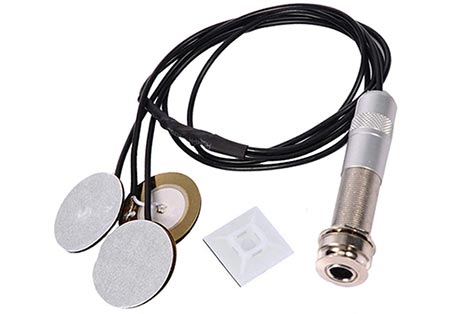
Piezo pickups work differently from all the other magnetic pickups that we talked about. Instead of magnets picking up the electric signals that are translated and sent out to the amplifiers, the piezo pickups are located inside the bridge of the guitar and picks up the actual vibrations of the string and guitar. Therefore, it’s common to see these pickups being on acoustic instruments like nylon string guitars. Nowadays, you might also see them on electric guitars, and it’s used to create acoustic guitar sound from an electric guitar.
The piezo pickup actually measures the pressure of the guitar vibrations, which creates an electrical current. Piezo pickups take the unfiltered, actual sound of the guitar whether it’s acoustic, nylon-string, or electric. The resulting tone is often on the bright side, and you get a very clear and articulate tone. Another advantage of the piezo pickup might be that there is no electrical hum because piezo-electric pickups don’t use any magnets.
7. Magnetic Pickups (Acoustic Guitar)
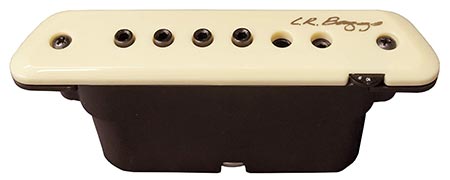
These are essentially the same type of pickups as magnetic pickups for electric guitar. The magnetic soundhole pickup for acoustic guitar works with insulated copper wire around a magnet in the middle. The magnetic flux picks up the vibration frequency from the steel strings and transfers it to the amplifier or PA system. The sound characteristics are similar to magnetic pickups on electric guitars, and it has responsive and quite warm sound that is easy to use for playing through acoustic guitar amplifiers and recording purposes.
Magnetic pickups on acoustic guitars do a great job of picking up the warm sound quality from acoustic pickups, and they are relatively easy to install, compared to other types of acoustic guitar pickups. For installing, all you need to do is just fit the magnetic pickup into the guitar soundhole and turn a couple of screws to put it in place. But what the magnetic pickups lack, are their ability to capture the depth and the resonance from the acoustic guitar body. Pickups like piezo/transducer pickups might capture more depth and resonances from inside the guitar body, and unfortunately, the magnetic pickups for acoustic guitars don’t have the ability to capture that much depth from the guitar body. Another disadvantage of magnets pickups on acoustic pickups is that they are more prone to receiving feedback from the acoustic guitar. Especially when you turn up the volume or use a lot of gain, you will need to really watch out for feedback and make sure you have it under control. Plus, these pickups won’t work at all with nylon-string guitars.
8. In-Body/Internal Microphones (Acoustic Guitar)
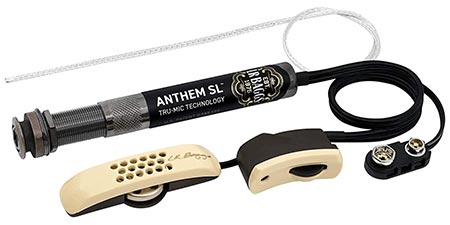
Internal microphones work by placing a small microphone inside the soundhole, and just like a regular microphone, it picks up the vibrations from inside the guitar. Compared to magnetic pickups, these small microphones will pick up more of the natural tone and acoustic qualities of the acoustic instrument. It will pick up things like percussive playing on your acoustic guitar body, and you’ll get a more of the woody quality from the microphone out to the amps or speakers. Out of the three acoustic guitar pickup systems we looked at, the internal microphones will best represent the natural acoustic tone of your guitar. But the downside is that you might experience more feedback from the pickup and that’s why the microphone placement is extremely crucial when it comes to internal microphones. Therefore, the installation will be quite tricky, and you will either already have a working knowledge of Piezo pickup installation or use the help of a guitar technician or a repair center.
Bass Guitar Pickups
The magnetic pickups you’ll encounter will come in 3 flavors: “split-coil” pickups, made famous by the Fender Precision Bass, “single-coils” featured on the Fender Jazz Bass, and “humbuckers” or “dual-coils” as are found on MusicMan Basses.
9. P-style (Bass Guitar)
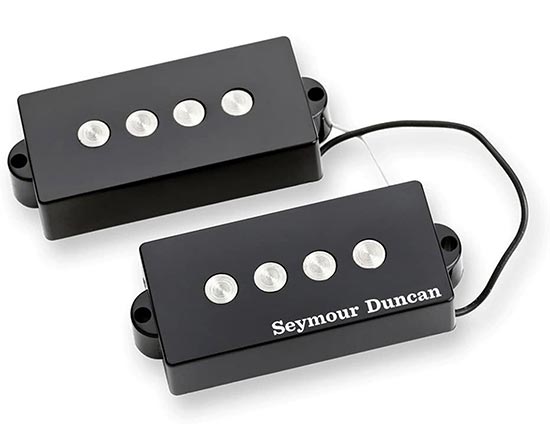
The first magnetic pickup ever made for a production model bass was a single-coil pickup on the 1951 Precision Bass made by Fender. It had the basic single-coil design that endures to this day: four magnets ( one for each string) with exposed pole-pieces wrapped in a copper-wire coil. Fender later changed the single-coil with the now legendary “split-coil” P-bass pickup.
The P-style pickup featured a few improvements over the original. They took a standard single-coil pickup and split it into two halves, basically creating two pickups that they wired together, performing as a single unit. They also added more coil wraps, increasing the size of the pickup. This resulted in a pickup with higher output and reduced noise, as single-coils were prone to pick up noise from electromagnetic sources such as amps, radios, stage lights, and so on. The P-style pickup was also the first “humbucking” pickup, although its two single-coil halves were offset: half of the pickup was used for the E and A strings, with the other half for the D and G strings. The result was a bass guitar with a buttery smooth low-end and a lot of midrange growl, which defined the early rock ‘n roll bass sound. The only drawback of the P-style pickup was its lack of high-end sparkle, which Fender addressed later on with the Jazz Bass and its classic two single-coil layout.
The P-style form-factor remains mostly unchanged, but there are some variations to the classic design. In addition to the standard split-coil, you’ll also encounter fully enclosed P-style pickups. This design is less inclined to degrade over time as the coils are sealed in resin.
Popular Related Article: 10 Incredible P Bass Pickups You Need To Check Out
10. J-style (Bass Guitar)
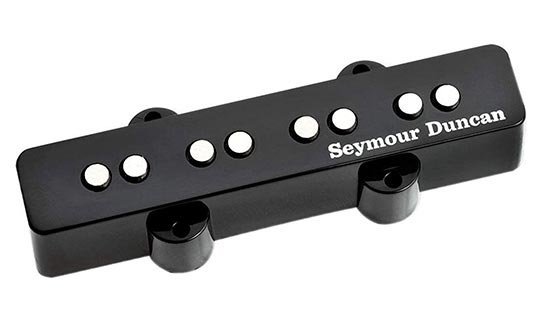
In 1960 Fender released the Jazz Bass as the “premium” model in their lineup. It borrowed many design elements from the Jazzmaster guitar. The Jazz Bass featured two single-coil pickups (very similar to the original 1951 P-Bass pickup), each pickup consisting of 8 magnets (two magnets with exposed pole pieces for every string), but again enlarged for higher output, one positioned near the bridge, and the second one placed towards the neck. The neck pickup is defined by a thick and airy tone while the bridge pickup sounds tight and punchy. They still picked up a lot of hum when the volumes were not set to the same levels. Single-coils are usually long and slender, each unit covering all four strings on the bass guitar, and are often described as sounding clear and bright in comparison with split-coil pickups. As the name suggests, this pickup style is preferred by jazz bassists but is not limited to that style of music (there are a lot of metal and rock bass players using Fender Jazz Basses or J-style pickups in their instruments of choice).
The J-style single-coils also come in the resin-coated, fully enclosed variety without the exposed pole pieces, eliminating the issues regarding humidity leading to the corrosion of the coils that will degrade the pickup and alter its tone.
Popular Related Article: 15 Jazz Bass Pickups You Need To Know About
11. Noise-canceling single coils (Bass Guitar)
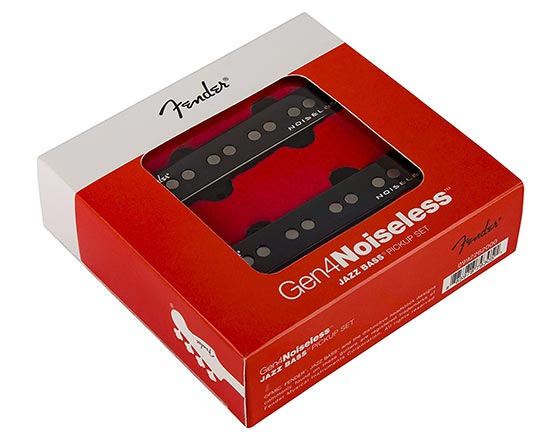
Single-coil pickups will pick up hum or electromagnetic interference from your environment, be it from fluorescent lighting sources, tube amps, radios, or computer monitors. To address this issue, manufacturers created the noiseless single-coil pickup. These are not single-coils in the true sense, as they are more closely related to “humbuckers” having two coils per pickup. But while in a true humbucking pickup the coils are positioned side-by-side, with the noiseless variety the two single coils are stacked on top of each other and have different windings or copper wire gauges, separated by a metal plate. They are in essence humbuckers because they buck the hum, but from a tonal standpoint, they sit somewhere between humbuckers and single-coils. Purists and fans of the single-coils sound still prefer true single-coils as they are brighter and punchier.
Their name also creates some confusion because they are single-coils only regarding their form factor.
12. Humbuckers or Dual Coils (Bass Guitar)
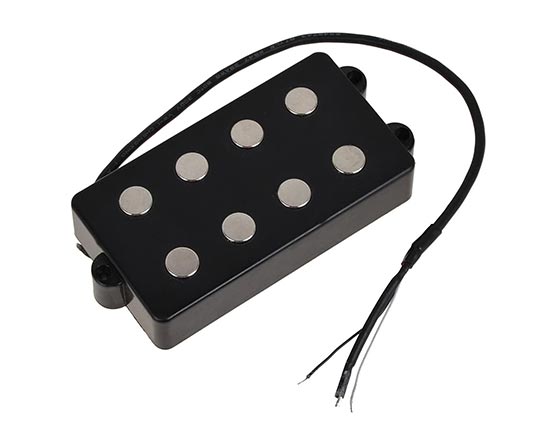
Humbucking pickups for bass guitars were introduced to “buck the hum” of the classic single-coils of the 60’s jazz basses. They were initially designed in the Gibson guitar factory by wiring two single-coils together, side-by-side, and out of phase with each other. This cancels out the electromagnetic interference single-coil pickups are known for while producing a harmonically rich sound with lots of low end. Because they are in essence two glued-together single-coils, they have a much higher output and as a result, are louder and have more gain than any other type of magnetic pickup. When compared to the P-style pickup (with which they are more closely related to, sonically), they have a tighter low end and an even more pronounced midrange. This is why Music Man basses are so well regarded in the rock scene. As with the P-style pickup (also a humbucker), the highs are attenuated because of the basic design of the pickup.
13. Soapbar pickups (Bass Guitar)
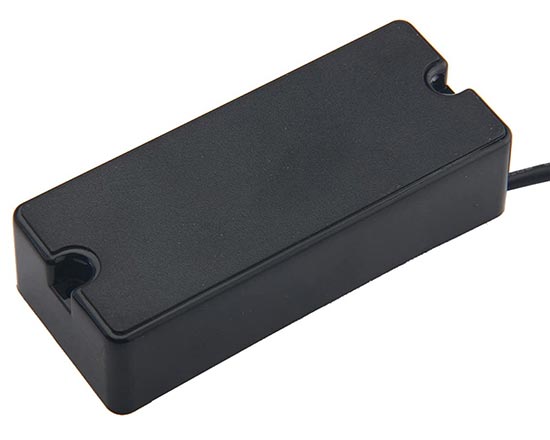
This term only describes the enclosure for the pickup (they look like black soap bars), and they are usually humbuckers although this form factor is sometimes used for “noiseless single-coils” (still technically a humbucker pickup) or single-coils.
14. Active pickups (Bass Guitar)
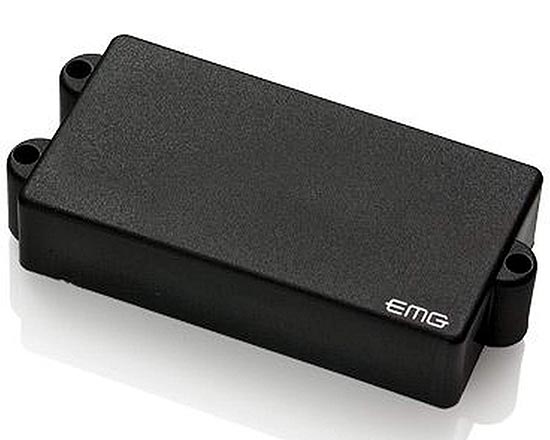
Active pickups are a variety of magnetic pickup that features a powered preamp in its design. The preamp usually runs on a 9V battery (sometimes two) and is used to drive your signal consistently through to your amp. This is not the same as an active preamp circuit in your bass that lets you EQ your sound. Though you will find them most often paired with an active preamp. Active pickups just boost your signal for more consistency but at the cost of removing some of the dynamics in your playing. This can be useful if you play music genres where your volume stays more or less at the same level and doesn’t require as much nuance in your tone, as with metal or punk.
15. Bass Piezo pickups (Bass Guitar)
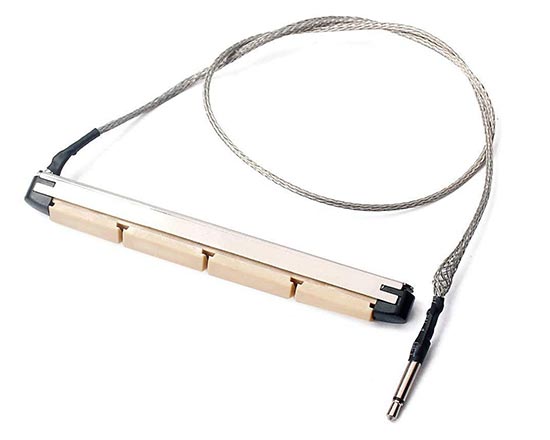
In contrast to a magnetic pickup that senses the changes in the magnetic field while the strings vibrate above it, a Piezo pickup senses the vibrations of the instrument itself and converts this vibration into an electrical signal, making it the main type of pickup employed when amplifying acoustic instruments. Since piezo pickups don’t rely on magnets, they can be used with non-ferromagnetic strings, such as nylon strings. Usually, piezo pickups are either placed directly under the bridge of the instrument or, in the case of some electric bass guitars, inside of the bridge, each string having its own piezo pickup. A piezo pickup is very bright sounding and has a much faster attack when compared to magnetic pickups. Bass players have found that pairing the fast attack and brightness of a piezo with the pronounced low end and midrange of a magnetic pickup produces great-sounding tones while vastly improving the versatility of the instrument. A piezo pickup on bass needs the right kind of active preamp to avoid sounding brittle and thin and also to dial in the right mix between the magnetic and piezo pickups.
16. Bass Optical Pickups (Bass Guitar)
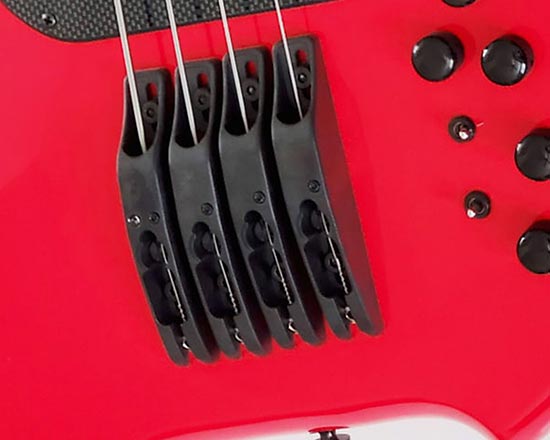
Optical pickups have been around for almost 50 years but their use as bass pickups has not been very popular. Only in recent years have professionals started to consider them as worthwhile alternatives or complements to magnetic pickups. Optical pickups use light to detect the string vibrations. A LED is pointed at each string and a light-sensitive detector measures the refracted light as the string vibrates and converts the measured vibrations into an electrical current sending it down your signal path to be amplified. This makes them very accurate and leads to some major improvements when compared to magnetic pickups.
Optical pickups are immune to outside interference and don’t produce any hum or noise. They have a broader frequency range at any volume level with a completely flat response curve as there is nothing but light being refracted off of the string. An optical pickup will also have increased sustain when directly compared to a magnetic pickup, as magnetic pickups slightly pull on the string due to their magnetic field, and as a consequence, lowering the amount of sustain. The design of the optical pickup makes it very good when a clean signal is desired but they are not as good with effects such as distortion. Many bass players still prefer the “dirtier” sound of a traditional magnetic pickup over the optical kind, due to its perceived lack of character and the slight drawback when using effects.
Common Questions
What Exactly is a Guitar Pickup?
Before we go in-depth into the subject of pickups, let’s first establish a solid foundation on what exactly a pickup is and what it’s not. Pickups are electronic devices that are composed of magnets and wires, and the magnets essentially pick up the vibrations from the strings of electric guitar. The vibrations that are picked up through insulated copper wire coils and magnets are transferred to the amplifier, which is what you hear when you play a note on an electric guitar using a guitar amplifier.
What is the Difference Between Passive Pickups and Active Pickups?
Pickups in general can be classified into two types of pickups, active and passive pickups. Both are very different in their operating methods, and both have their own unique traits that all guitar players should know about. The original and the most common type of pickups are passive pickups, and you can think of everything from single coil pickups to P90 pickups. The passive pickups don’t necessarily boost or add anything to the signal, and they sort of pick up the natural tone of the instrument. The tone from passive pickups tends to be warm, but the downside is that the tone is not as powerful as active pickups when it comes to high-gain or high-distortion type situations.
What’s the Difference Between Coil Split and Coil Tap?
Coil split and coil tap are two common features you can find on modern guitar pickups. These two terms are often confused a lot these days, and these two terms don’t mean the same thing.
Coil split specifically applies to humbuckers and humbuckers only. Humbuckers come with two coils of wire that cancels out the unwanted noise and hum, and the two coils of wire also result in larger output. When the coil split function is enabled, the connection between the two coils is broken, and only one of the two coils of wire is enabled. And that’s precisely why with coil split function, you can get a single coil pickup tone out of a humbucker. This gives guitarists a huge selection of tones to choose from, and the possibilities of different tones multiply. In most cases, coil split is enabled by clicking on the tone knob of the guitar.
Coil tap function refers to single coil pickups exclusively. Just like coil splitting, coil tap function also decreases the overall output of the pickup. When coil tapping is enabled, the signal is taken from somewhere within the coil, rather than the very end of the coil. This leads to smaller signals and you get a weaker output. Coil tapping is definitely not as popular as coil splitting amongst guitar players, but they are still very useful for high-output single coil pickups. One example use would be by using coil tapping on a modern high-output single coil pickup, you can make the single coil pickup sound more like a vintage Fender single coil by lowering the output.

My name is Chris and I’ve had a passion for music and guitars for as long as I can remember. I started this website with some of my friends who are musicians, music teachers, gear heads, and music enthusiasts so we could provide high-quality guitar and music-related content.
I’ve been playing guitar since I was 13 years old and am an avid collector. Amps, pedals, guitars, bass, drums, microphones, studio, and recording gear, I love it all.
I was born and raised in Western Pennsylvania. My background is in Electrical Engineering, earning a Bachelor’s degree from Youngstown State University. With my engineering experience, I’ve developed as a designer of guitar amplifiers and effects. A true passion of mine, I’ve designed, built, and repaired a wide range of guitar amps and electronics. Here at the Guitar Lobby, our aim is to share our passion for Music and gear with the rest of the music community.

Q: I bought MEC passive pickups for my Fender Jazz, I found that both pickups have same magnet polarity, is it the same rule than other single coil having opposite polarity to cancel noise ? Are these pickups considered as single coil or, do they even have a coil ? and if not, how do they work ?